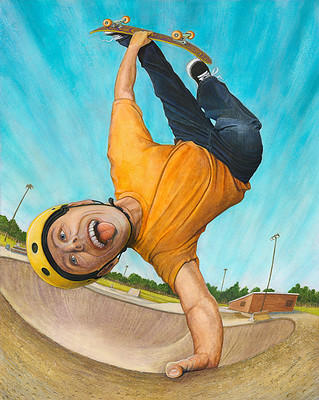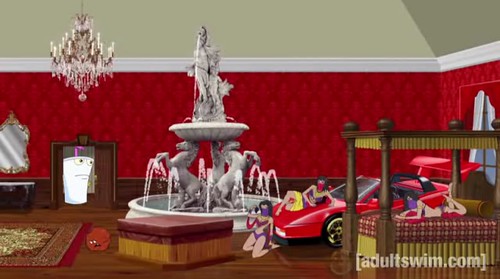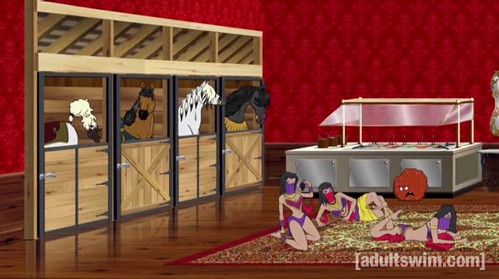Just created this process video for my Materials and Techniques II class at SCAD. Enjoy!
Wednesday, February 24, 2010
Thursday, February 18, 2010
Brian Despain
SCAD Atlanta Illustration Dept. had a wonderful opportunity on Wed. Feb 17th with Illustrator turned fine artist Brian Despain. His Agent, Kirsten Anderson, of the owner and curator of Roq La Rue gallery in Seattle was scheduled for a lecture at SCAD on Feb 18th at 6pm behind the hub. Professors Mike Brown and Kenneth Knowles were working with Kirsten for the painting Dept. Brian was driving up from Florida (where he was staying) to meet with her at SCAD for some business. So we got lucky to have such an amazing talent or as his Dad would say "the best thing since sliced bread" to come a do a lecture and demo for the Illustration Dept. It was a great collaboration with the Painting and Illustration Departments that should happen more often. There was a pretty descent turn out with students and faculty. Thanks for all that showed up.

Brian was a wonderful speaker and a self admitted artist that likes to be in complete control of not only his paintings subject matter, but every step in his image creation process. Coming from a commercial art background doing a wide variety of graphic design jobs, photo-retouching, video game 3D Modeler, but never really a full-time freelance illustrator. Now for the past few years he has really hit the gallery scene with his stormy clouds, robots, fish, numbers and other elements that captivate the viewers attention much longer than the typical quick read illustration. He talked extensively about his philosophy of art and the connection with the viewer.
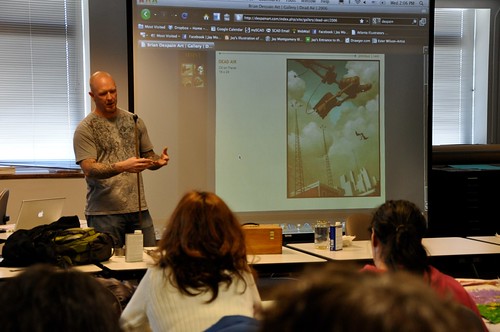
He had prepared a painting to start that was due in a month for a gallery show that his agent, Kirsten, was presenting. He starts with an idea, refines it with pencil, scans it in and in Photoshop and Painter he does a really tight color study while still working on fixing details, proportions and angles. This goes pretty quick with digital tools to take about 3 hours or so. Most of his work as relatively small , but he can but a ton a detail in the piece even at 8" x 10" or 11" x 14". The piece he was working on was 11" x 14". He "glues" a tight line drawing print to a sturdy hardboard. He does this first by sealing absorbent board with matte medium, sanding it smooth. Then he brushes on a layer of matte medium on the board and the back of the print which is on 3 ply bristol. He positions the bristol paper that is slightly larger than the board. Cuts off the excess paper. Then brushes it down and seals the bristol with about 5-6 thin coats (sanding in between dried layers) on top of the drawing. The results is a sealed smooth surface to paint on. He then prints out an color and black and white version of the color study.

Painting in oils, Brian has a developed a very controlled and meticulous process that works very well for him. I certainly can't cover every aspect of his detailed painting process, but here is an overview from what I gathered. Feel free to further discuss this in the comments.
He uses the old masters technique of grisaille, which is basically starting with only gray tones of all the details of the painting then colorizing it with several thin layers of color on top of the dried grisaille. His gray color is a 1 to 1 mix of Ultramarine Blue (I think) and Burnt Sienna which produces a neutral gray. He has a special mix of his own oil medium which is three parts linseed oil, two to three parts stand oil and one or two parts oil of spike lavender. He likes the strength and elasticity of the stand oil but it’s too thick to use on its own, and the oil of spike is used as a diluent to speed drying time. Brian uses the oil of spike instead of say, turp as a diluent as it’s not as toxic though it is quite expensive. On his glass palette he adds his medium to the paint with a water dropper controlling the amount mixed in. With a palette knife he mixes then medium into both colors then mixes then together to create a neutral black. Then with white he mixes 4-5 grey tones on his palette.
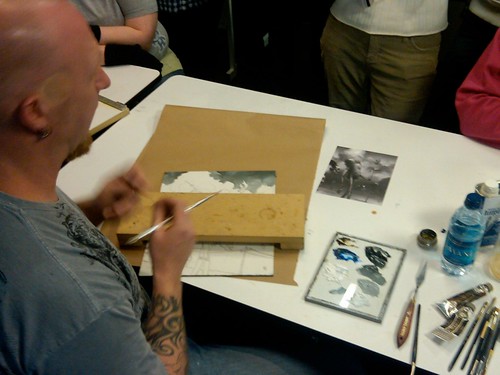
Then finally with cheap small fine haired flats, filberts, and round brushes he starts from the top down rendering the whole painting precisely in grey tones. His layers are very thin to increase the dry time but still stays workable on the board for the length of the painting session. Once the grisaille is dry he starts in with the color.

Brain uses a palette of 11 oil colors that he exclusively uses on all his paintings. He developed a set of color mixing charts showing how all the color interact with each other and by adding white in varying value ranges. He refers to this constantly during the coloring painting stage. His favorite brand of oil paint is Rembrant and some Daniel Smith. To colorize the grisaille he uses a bit more of the same medium without thinners for a glaze showing the tone underneath the color. A painting this size would take him about 2-3 days do to after all the prep work is done working full days and drying the painting overnight.
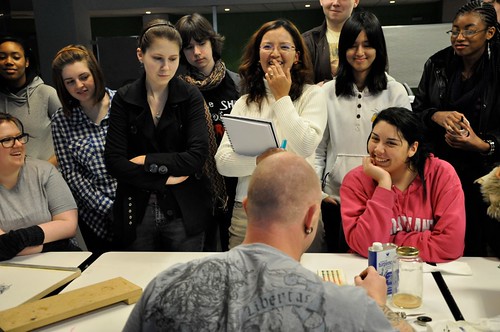
It was a real treat not only for the students, but the professors as well to see and hear about his philosophy of art and method of his madness and "pro tips". I know I was thoroughly enlightened! Thank you Brian for a fantastic and well-received lecture/demo. It was more than we all expected. You are welcome at SCAD anytime!

Brian was a wonderful speaker and a self admitted artist that likes to be in complete control of not only his paintings subject matter, but every step in his image creation process. Coming from a commercial art background doing a wide variety of graphic design jobs, photo-retouching, video game 3D Modeler, but never really a full-time freelance illustrator. Now for the past few years he has really hit the gallery scene with his stormy clouds, robots, fish, numbers and other elements that captivate the viewers attention much longer than the typical quick read illustration. He talked extensively about his philosophy of art and the connection with the viewer.

He had prepared a painting to start that was due in a month for a gallery show that his agent, Kirsten, was presenting. He starts with an idea, refines it with pencil, scans it in and in Photoshop and Painter he does a really tight color study while still working on fixing details, proportions and angles. This goes pretty quick with digital tools to take about 3 hours or so. Most of his work as relatively small , but he can but a ton a detail in the piece even at 8" x 10" or 11" x 14". The piece he was working on was 11" x 14". He "glues" a tight line drawing print to a sturdy hardboard. He does this first by sealing absorbent board with matte medium, sanding it smooth. Then he brushes on a layer of matte medium on the board and the back of the print which is on 3 ply bristol. He positions the bristol paper that is slightly larger than the board. Cuts off the excess paper. Then brushes it down and seals the bristol with about 5-6 thin coats (sanding in between dried layers) on top of the drawing. The results is a sealed smooth surface to paint on. He then prints out an color and black and white version of the color study.

Painting in oils, Brian has a developed a very controlled and meticulous process that works very well for him. I certainly can't cover every aspect of his detailed painting process, but here is an overview from what I gathered. Feel free to further discuss this in the comments.
He uses the old masters technique of grisaille, which is basically starting with only gray tones of all the details of the painting then colorizing it with several thin layers of color on top of the dried grisaille. His gray color is a 1 to 1 mix of Ultramarine Blue (I think) and Burnt Sienna which produces a neutral gray. He has a special mix of his own oil medium which is three parts linseed oil, two to three parts stand oil and one or two parts oil of spike lavender. He likes the strength and elasticity of the stand oil but it’s too thick to use on its own, and the oil of spike is used as a diluent to speed drying time. Brian uses the oil of spike instead of say, turp as a diluent as it’s not as toxic though it is quite expensive. On his glass palette he adds his medium to the paint with a water dropper controlling the amount mixed in. With a palette knife he mixes then medium into both colors then mixes then together to create a neutral black. Then with white he mixes 4-5 grey tones on his palette.

Then finally with cheap small fine haired flats, filberts, and round brushes he starts from the top down rendering the whole painting precisely in grey tones. His layers are very thin to increase the dry time but still stays workable on the board for the length of the painting session. Once the grisaille is dry he starts in with the color.

Brain uses a palette of 11 oil colors that he exclusively uses on all his paintings. He developed a set of color mixing charts showing how all the color interact with each other and by adding white in varying value ranges. He refers to this constantly during the coloring painting stage. His favorite brand of oil paint is Rembrant and some Daniel Smith. To colorize the grisaille he uses a bit more of the same medium without thinners for a glaze showing the tone underneath the color. A painting this size would take him about 2-3 days do to after all the prep work is done working full days and drying the painting overnight.

It was a real treat not only for the students, but the professors as well to see and hear about his philosophy of art and method of his madness and "pro tips". I know I was thoroughly enlightened! Thank you Brian for a fantastic and well-received lecture/demo. It was more than we all expected. You are welcome at SCAD anytime!
Tuesday, February 09, 2010
Aqua Teen Hunger Force background!
After working on 6 movie backgrounds for Cartoon Network's "Aqua Teen Hunger Force colon Movie Film for Theaters" (yes, this is the full title exactly). They called on my pixel pushing skills again for the TV show. Just this past Sunday the new episode of the Adult Swim TV show Aqua Teen Hunger Force "Rabbot Redux" aired and it had about 2 min of air time using a background I did! Took about 2-3 weeks to do back in December
2009. A bit about the creation process.

2. I established eye an level horizon line using one point perspective. Then I created most of the base mechanical/architectural shapes in Illustrator CS4 then by copying and pasting into Photoshop CS4 I created several smart object layers.

3. I sent progress to the AD a couple of times. I did not do the Ferrari. They already that done, I just had to make sure the perspective matched the rest and fit in between the bed and fountain. I had to make sure that the layers of objects were set up in such a way that the characters could go behind all the elements. So each object was on it's own layer with transparent backgrounds.

If you want to see the whole episode you can go to this direct link on the Adult Swim website, but I must warn you that it's NSFW, but not R rated. It's not the type of crude humor that everyone can appreciate. (If there is such a humor.) It's only a 15 min show, but to skip right to the scene go to the end of the first video clip and the next clip will load and it's toward the beginning of that video file.
2009. A bit about the creation process.
1. This is what the Art Director, Bob Pettitt, sent me as a starting point. This was used as a "holder" for the animation build of the scene. After talking with me about the scenes needs and he sending me a few texture files, food items for the salad bar I got started.

2. I established eye an level horizon line using one point perspective. Then I created most of the base mechanical/architectural shapes in Illustrator CS4 then by copying and pasting into Photoshop CS4 I created several smart object layers.

3. I sent progress to the AD a couple of times. I did not do the Ferrari. They already that done, I just had to make sure the perspective matched the rest and fit in between the bed and fountain. I had to make sure that the layers of objects were set up in such a way that the characters could go behind all the elements. So each object was on it's own layer with transparent backgrounds.

4. After creating in smart objects in Photoshop, I used them as clipping masks to add textures mainly. On some smart object layers I added shadows and highlights as clipping masks. This is the final background low res version. The original is 12000 x 3240 pixels (40in x 10.8in at 300 dpi) with 411 layers! High Def Baby!
Some details - indoor horse stable!

fancy luxury bed! I used the Vanishing Point filter and the Liquify filter to apply the bed spread pattern.
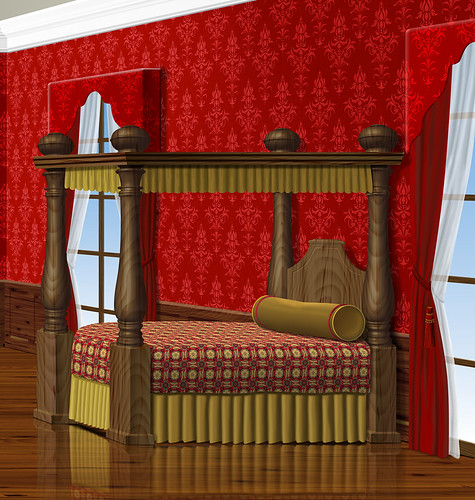

fancy luxury bed! I used the Vanishing Point filter and the Liquify filter to apply the bed spread pattern.

Some screen shots of how they used them in the end. It was about 2 min of airtime. Pretty funny little scene.
If you want to see the whole episode you can go to this direct link on the Adult Swim website, but I must warn you that it's NSFW, but not R rated. It's not the type of crude humor that everyone can appreciate. (If there is such a humor.) It's only a 15 min show, but to skip right to the scene go to the end of the first video clip and the next clip will load and it's toward the beginning of that video file.
Labels:
backgrounds,
illustration,
new commission,
news,
process
Subscribe to:
Posts (Atom)
























